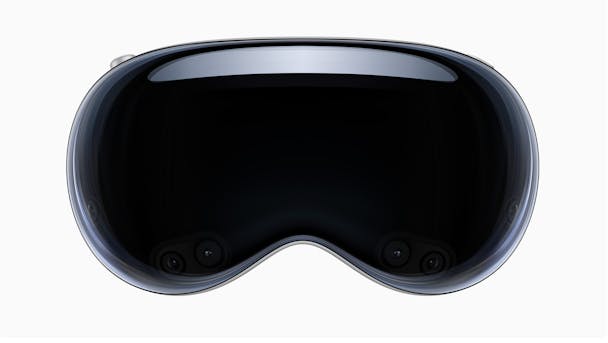Apple Vision Pro hits shelves across the US
The tech giant is positioning its new device as the first of its kind in the emerging “spatial computing” market.

The Vision Pro is now available for $3,499. / Apple
Apple’s long-awaited Vision Pro headset – a wearable device that blends virtual reality (VR) with augmented reality (AR) – was released in stores across the US today.
Company CEO Tim Cook, who greeted a long line of customers this morning at Apple’s flagship store in New York City, has called the Vision Pro “the most advanced consumer electronics device ever created.” It’s being sold for $3,499, a price tag that’s likely to turn off all but the most devoted Apple fans, at least in the short term.
Apple is a latecomer to the VR/AR wearable space – Meta released the first Quest headset in the spring of 2019 – but the Vision Pro delivers some benefits that could enable the company to quickly make up for lost time. Its form factor, for one thing, has the polished look for which Apple has become famous, and early reports suggest that it’s both lightweight and comfortable, a marked contrast to other headsets that are already on the market.
Advertisement
Even if the Vision Pro is unlikely to be a mainstream hit anytime soon, Rosh Singh, managing director at Unit9 – a production agency which helps brands develop digital experiences – believes that Apple could quickly establish itself as the dominant force in the VR/AR headset space due to what he calls “the Apple factor”: “They have the strongest brand, [and] they have a track record of making great hardware and software,” he says. “They just have an ability to make us see the value in things [in a way that] other companies cannot do.”
This quality, in Singh’s view, stretches back to the company’s earliest “Steve Jobs and Jony Ive days,” during which time the bulk of attention was spent on “meticulous attention to detail and product design.” Singh doubts that Apple still has that same creative energy within the company, but he says the “reputational currency” they’ve collected over the years is probably sufficient for them to be able to continue to maintain their reigning position in the tech world.
Much of the marketing for the Vision Pro has been oriented around a concept known as “spatial computing,” which is best thought about not as a single technology with a clear-cut definition but rather as a spectrum of technologies enabling a novel kind of user experience. “Just as the Mac introduced us to personal computing and iPhone introduced us to mobile computing, Apple Vision Pro introduces us to spatial computing,” Cook has said in a statement.
Advertisement
Rather than taking place behind a screen, spatial computing experiences are overlaid directly upon a user’s environment, creating the sense of being able to directly engage with virtual environments or objects. Singh describes it as “3D experiences that feel more embodied and more interactive.”
The spacial computing market might be niche at the moment, but Singh believes it could soon gain mainstream appeal as hardware becomes less bulky, manufacturing costs decrease, a greater number of brands enter into the space and more marketable use cases emerge.
During these early days, not every brand is likely to find a viable way to leverage the Vision Pro and other spatial computing devices as a means of marketing and audience engagement. Entertainment companies are an obvious exception, considering the Vision Pro’s ability to deliver immersive, 3D viewing experiences. Last month, Disney+ announced a partnership with Apple which will allow users to stream titles while wearing the headset.
Suggested newsletters for you
For now, Singh says, brand marketers should at the very least begin to think seriously about how they might eventually leverage spatial computing. But he also warns against being overly hasty, as he believes many brands were not so long ago in response to hype surrounding the metaverse. “The metaverse gold rush a couple of years ago is indicative of what you should never do, which is to do things [just] for the sake of it,” he says. “There needs to be an authentic entry point into these things because otherwise your consumers will sniff it out and realize that it’s nothing more than an attention-grabbing exercise.”
For more on the latest happenings in AI, web3 and other cutting-edge technologies, sign up for The Emerging Tech Briefing newsletter.

